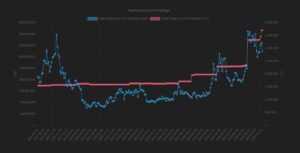USD Tether is the largest and most widely used stablecoin in cryptocurrency markets and is seemingly too big to fail at this point. However, concerns about the stablecoin’s legal status and past behaviour are a source of various arguments levied against it, some of which have merit and others that are conjecture at best.
The Tether Cloud explained
Tether is a US Dollar stablecoin that aims to mimic the value of the US dollar in digital format using various blockchain (predominantly Ethereum). According to figures from CoinGecko, it is the largest stablecoin and 3rd largest digital asset with a $21bn market cap, and rapidly growing.
Over the years Tether has been at the centre of transparency issues, specifically over its reserves. More recently, bitcoin’s parabolic price increase has caused bears to wonder whether there was foul play by the Tether printer.
This brief piece aims to outline the issues and the facts which investors ought to know when holding or trading USD Tether.
Tether counterparty risk
Tether’s lack of clarity warrants scepticism. For those less familiar with prior Tether mishaps, the stablecoin originally promised 100% currency reserves, which is to say that every dollar would be redeemable for every USD Tether coin. However, in May 2019, that changed and the small print stated that reserves were backed by cash, cash equivalents and loans.
Essentially, Tether changed its model to fractional reserve banking in 2019, which creates a counterparty risk should liquidity drain out of Tether due to a loss in confidence or some other event. This is not exactly a novel idea since most traditional banks operate in the exact same manner. Should a run on Tether occur and it cannot meet redemptions then that creates a significant risk (all be it short term) to non-blue chip digital assets.
Buying bitcoin? Start here.
The same way there was a complete collapse of the banking system in 2008, there’s a scenario where this could happen in the crypto world. However, considering that bitcoin is a means of exiting this risk with a market cap of $700 billion, a ‘Tether run’ would be a minor blip in the coin’s timeline.
If Tether reserves are worrisome, investors can sit in normal cash or even in Goldman Sachs-backed USD Coin – if that makes you feel more comfortable.
When it comes to Tether’s ability to maintain its peg, Bitfinex (a Tether founder) provides a zero fee 1USDT:1USD pairing that incentivises arbitrage opportunities between exchanges, allowing the stablecoin to maintain its peg. If a liquidity drain were to happen though, it’s unlikely for Tether to maintain this peg.

In prior problematic scenarios, Tether has managed to recover, and it could be argued that the technical risk is lower now than it was in 2018 given the industry’s maturity and growth. Still, this is the risk for Tether holders regardless of the narrative. It is the same risk that exists in traditional finance, in large part because it is the bridge between the old and the new.
Unbacked Circulation?
The most prominent issue relation to Tether speculation has been the printing of un-backed stablecoins for themselves and in turn manipulating its trading pairs via fake liquidity.
Let’s be clear, there is absolutely zero empirical evidence supporting these claims, but in a forward-looking market it’s normal to expect bears to speculate on such matters.
Meanwhile, investors who remain uneasy about Tether can look to alternative stablecoins to allay concerns. That said, USDT is regulated by FinCEN, and Bitfinex CTO Paolo Ardoino recently pushed back on various rumours about Tether.
“Reminder: #Tether is registered and regulated under FinCEN as all the centralised competitors. Strict KYC/AML is applied to all Tether direct users, as the other main issuers are doing. Less regulated is just FUD. Ask yourself who benefits from spreading such misinformation?”
Ultimately though, no audits have been commissioned to identify the state of Tether’s reserves since 2018, and perhaps this might soon change if Tether were to adopt Chainlink’s ‘proof of reserves’ use-case.
Regulators have a habit of picking winners and losers, and in this respect, we sincerely hope that Tether and US regulators can solve any remaining qualms sooner rather than later.
Read More: USD Tether hits $20 billion Market Cap as CBDC’s loom
Subscribe to the semi-weekly newsletter for regular insight into bitcoin and crypto. Go on. It’s free.
Join the telegram channel for updates, charts, ideas and deals.
Did you like the article? Share it!


